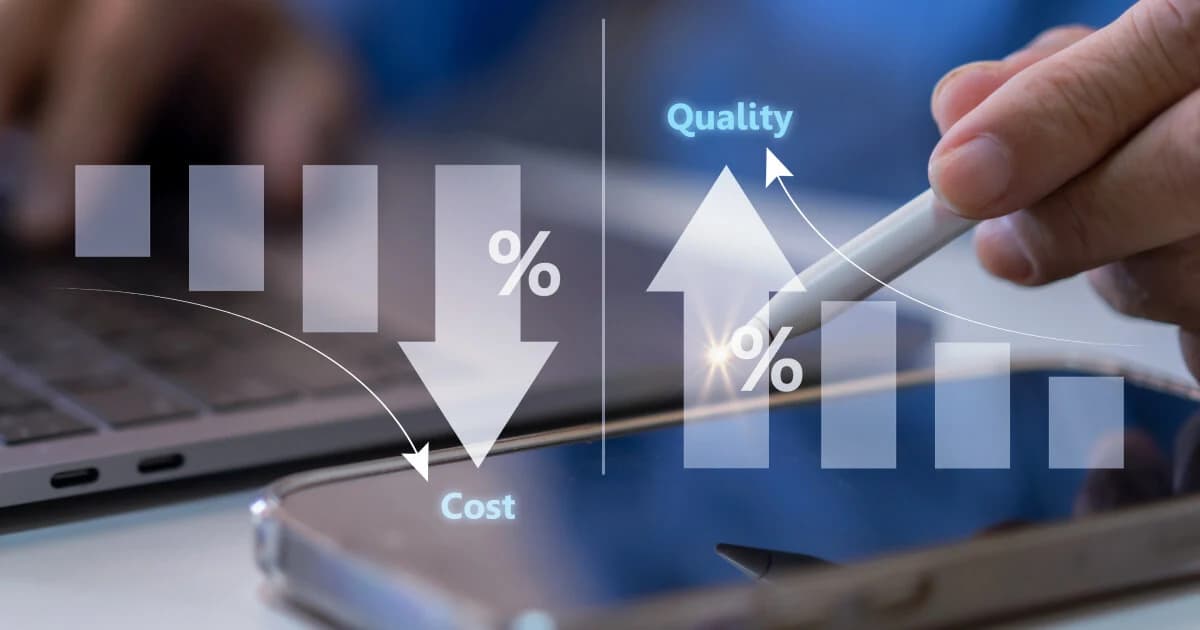The Missing Ingredient in Reducing Cost of Poor Quality

You can either choose to pay for good quality, or choose to pay for bad quality.
That’s the message of quality pioneer Philp Crosby and the American Society for Quality (ASQ), which reports that quality costs can run as high as 40% of annual revenue. For a thriving company, that number goes down to 10% or less, demonstrating that proactive quality improvement programs can exert significant effect on company performance.
The missing ingredient for many of the laggards: inadequate systems for preventing process nonconformances, which are the root cause of a large percentage of quality escapes.
Underlying this gap in manufacturing organizations today are several misconceptions around cost of quality and the most cost-effective strategy for reducing cost of poor quality (CoPQ).
Understanding the True Scope of Quality Costs
Survey data from LNS Research reveals that more than 4 in 10 manufacturers don’t know what their total cost of quality (TCoQ) is. Even for those that think they understand their quality costs, the reality is that companies often only see part of the picture.
Metrics like scrap and warranty costs are just the tip of the iceberg, especially when you take into consideration everything that happens after a quality escape. Moreover, even a full accounting of these costs doesn’t capture how much hidden factory processes cost the organization in terms of efficiency and productivity.
On a basic level, the hidden factory refers to any undocumented process that impacts quality in the background, for example when:
- An operator is reworking parts at their station due to an underlying quality issue
- Lag time between issue identification, reporting and resolution leaves time for problems to get worse
- A line supervisor speeds up cycle time when they get behind, unknowingly causing hidden damage to parts
These hidden factory processes create invisible costs that aren’t easily measured, while also potentially skewing productivity metrics to make the plant seem like it’s running better than it truly is.
Making Your Quality Dollars Count
One of the biggest mistakes companies make is treating prevention as an added cost, when in fact modest investments in prevention can deliver comparatively large decreases in CoPQ.
Total Quality Management refers to this as the 1-10-100 Rule, noting that every dollar spent on prevention saves $10 on appraisal and $100 in failure costs.
What does this mean for manufacturers looking to reduce CoPQ?
For one, underinvestment in prevention is a critical misstep that only serves to drive up correction and failure costs. Second—and perhaps more importantly—prevention and early detection are some of the most cost-effective investments a company can make to maximize the impact of their quality dollars.
Product Inspections Are Not Enough
Relying on product inspections isn’t enough to reduce CoPQ, given that they are focused on finding defects that already exist. Rather, companies must focus upstream of the point of manufacture on process nonconformances, which are a leading contributor to quality escapes.
Maybe it’s an operator taking a shortcut, a machine whose settings are just a little off, or a new process step that isn’t being followed consistently after a corrective action. In all of these cases, the root cause is process inputs not meeting standards.
This is the guiding principle behind layered process audits, which are short, focused checks used across industries such as automotive, aerospace, medical devices, electronics and consumer packaging.
Layered process audits typically take place daily, focusing on high-value process inputs such as whether:
- Operators can demonstrate job procedures and explain why they are important to quality
- Machine settings are correct
- Tools are in good working order
- Material inputs meet specifications
The key ingredients here are frequency and process focus. Combined, they provide more opportunities for preventing defects at their source to deliver larger savings than product inspections alone. A quick pre-shift check, for instance, can prevent hundreds of defects, including ones that may not be evident during final inspection.
How Going Digital Can Accelerate and Amplify Your Results
If you’re using manual processes such as paper checklists and spreadsheets to administer your audit program, know that these represent bottlenecks that will ultimately constrain your efforts to reduce CoPQ.
Low audit completion rates, reporting lag time and the sheer hassle of updating checklists hamper the ability to prevent and respond to issues, slowing the pace of improvement overall.
From a people perspective, there’s no effective way to capture what’s happening with workers on the plant floor, while leaders lack the information necessary to make data-driven decisions.
A digital audit and inspection platform eliminates all of the above bottlenecks to accelerate reductions in CoPQ and yield bigger savings overall. What’s important is finding a solution that’s agile and user-friendly, with a dynamic question library, scheduling automation and closed-loop issue management.
Examples of results manufacturers have achieved by switching to EASE software include:
- 50% reduction in quality costs
- 73% lower internal PPM
- 53% reduction in customer defects
Implementing digital process audits in your plant is a far less complex process than other digital transformation projects, and one that can deliver substantial CoPQ reductions. Prevention, process focus and connecting people digitally—when used together, these three ingredients have a synergistic effect that helps drive down CoPQ and create a culture of quality.